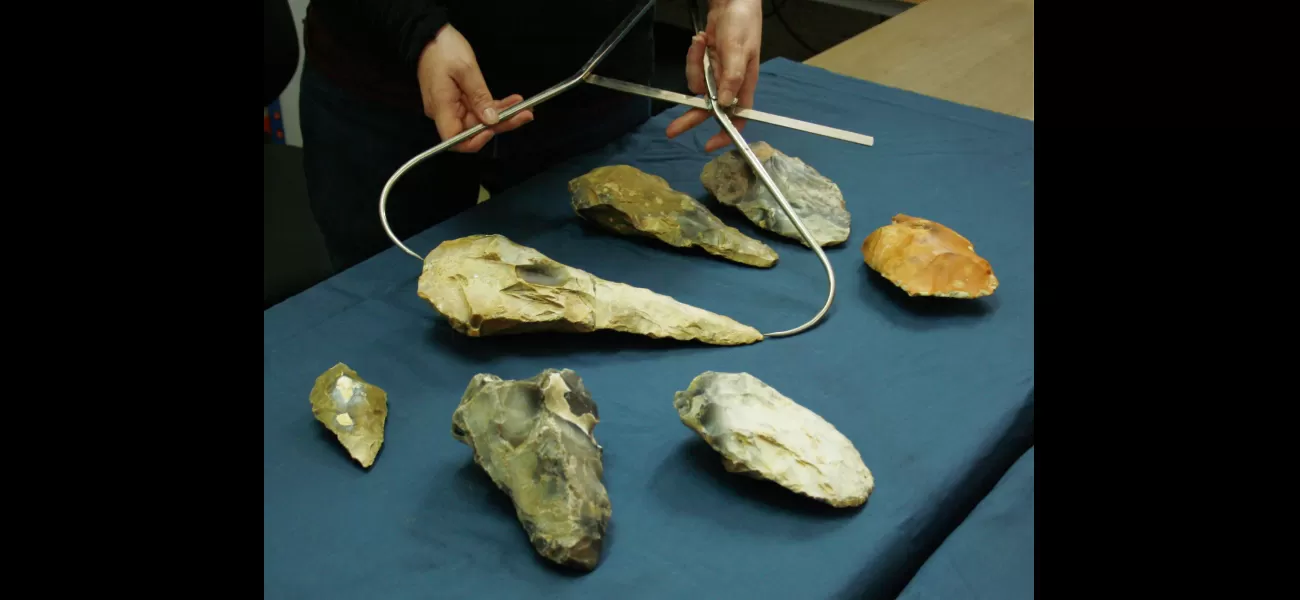Rare finds at Kent site include an Ice Age axe too big to handle.
Archaeologists conducted excavations in Kent to uncover artifacts.
July 5th 2023.

Archaeologists from UCL Archaeology South-East recently made a remarkable find in Kent. They uncovered 800 stone artefacts from deep Ice Age sediments that are thought to be more than 300,000 years old. Among these artefacts were two giant flint handaxes. These handaxes are remarkable for their size, measuring up to 29.5 centimeters long and being too big to be handled easily.
Handaxes were usually held in the hand and used for butchering animals and cutting meat. These two largest handaxes were found with a distinctive shape, featuring a long and finely worked pointed tip and a much thicker base. Senior archaeologist Letty Ingrey commented on the find, saying, “We describe these tools as ‘giants’ when they are over 22cm long and we have two in this size range. The biggest, a colossal 29.5cm in length, is one of the longest ever found in Britain.”
The site is thought to have been a wild landscape of wooded hills and river valleys inhabited by now-extinct species such as the straight-tusked elephant and lion. Archaeological finds of this age have been found in the Medway Valley before, but this is the first time they have been found as part of large-scale excavation.
The researchers are now working to better understand who created the artefacts and what they were used for. Dr Matt Pope of the UCL Institute of Archaeology said, “The excavations at the Maritime Academy have given us an incredibly valuable opportunity to study how an entire Ice Age landscape developed over a quarter of a million years ago. A programme of scientific analysis, involving specialists from UCL and other UK institutions, will now help us to understand why the site was important to ancient people and how the stone artefacts, including the giant handaxes helped them adapt to the challenges of Ice Age environments.”
The team also found a Roman cemetery dating back to at least a quarter of a million years later than the Ice Age activity. Collections of pottery and animal bones found nearby likely relate to feasting rituals at the time of burial. This provides further insight into life during this time period, and the researchers are excited to continue uncovering more information about this ancient culture.
Handaxes were usually held in the hand and used for butchering animals and cutting meat. These two largest handaxes were found with a distinctive shape, featuring a long and finely worked pointed tip and a much thicker base. Senior archaeologist Letty Ingrey commented on the find, saying, “We describe these tools as ‘giants’ when they are over 22cm long and we have two in this size range. The biggest, a colossal 29.5cm in length, is one of the longest ever found in Britain.”
The site is thought to have been a wild landscape of wooded hills and river valleys inhabited by now-extinct species such as the straight-tusked elephant and lion. Archaeological finds of this age have been found in the Medway Valley before, but this is the first time they have been found as part of large-scale excavation.
The researchers are now working to better understand who created the artefacts and what they were used for. Dr Matt Pope of the UCL Institute of Archaeology said, “The excavations at the Maritime Academy have given us an incredibly valuable opportunity to study how an entire Ice Age landscape developed over a quarter of a million years ago. A programme of scientific analysis, involving specialists from UCL and other UK institutions, will now help us to understand why the site was important to ancient people and how the stone artefacts, including the giant handaxes helped them adapt to the challenges of Ice Age environments.”
The team also found a Roman cemetery dating back to at least a quarter of a million years later than the Ice Age activity. Collections of pottery and animal bones found nearby likely relate to feasting rituals at the time of burial. This provides further insight into life during this time period, and the researchers are excited to continue uncovering more information about this ancient culture.
[This article has been trending online recently and has been generated with AI. Your feed is customized.]
[Generative AI is experimental.]
0
0
Submit Comment





